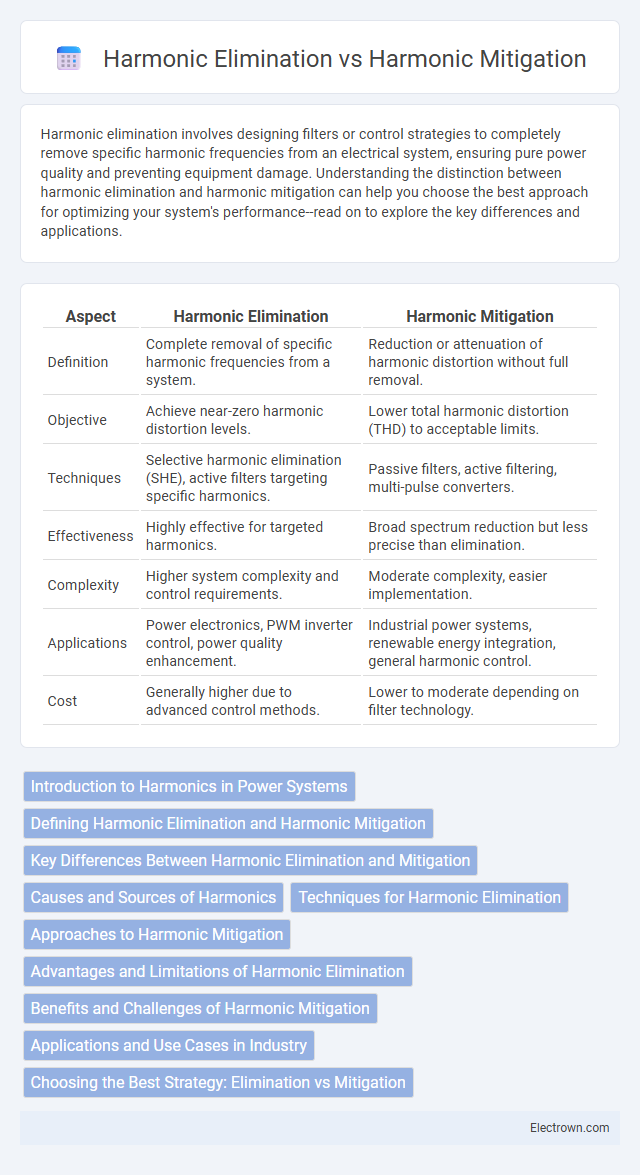Harmonic elimination involves designing filters or control strategies to completely remove specific harmonic frequencies from an electrical system, ensuring pure power quality and preventing equipment damage. Understanding the distinction between harmonic elimination and harmonic mitigation can help you choose the best approach for optimizing your system's performance--read on to explore the key differences and applications.
Table of Comparison
| Aspect | Harmonic Elimination | Harmonic Mitigation |
|---|---|---|
| Definition | Complete removal of specific harmonic frequencies from a system. | Reduction or attenuation of harmonic distortion without full removal. |
| Objective | Achieve near-zero harmonic distortion levels. | Lower total harmonic distortion (THD) to acceptable limits. |
| Techniques | Selective harmonic elimination (SHE), active filters targeting specific harmonics. | Passive filters, active filtering, multi-pulse converters. |
| Effectiveness | Highly effective for targeted harmonics. | Broad spectrum reduction but less precise than elimination. |
| Complexity | Higher system complexity and control requirements. | Moderate complexity, easier implementation. |
| Applications | Power electronics, PWM inverter control, power quality enhancement. | Industrial power systems, renewable energy integration, general harmonic control. |
| Cost | Generally higher due to advanced control methods. | Lower to moderate depending on filter technology. |
Introduction to Harmonics in Power Systems
Harmonics in power systems are distortions in the electrical waveform caused by non-linear loads, leading to increased losses, overheating, and equipment malfunction. Harmonic elimination targets the complete removal of specific harmonic frequencies through filters or active compensation, while harmonic mitigation reduces the amplitude of harmonics to acceptable levels to improve power quality. By understanding these approaches, you can enhance system reliability and comply with regulatory standards on harmonic distortion.
Defining Harmonic Elimination and Harmonic Mitigation
Harmonic elimination involves the complete removal of harmonic frequencies from electrical signals to ensure pure waveform output, typically achieved via specific filtering or inverter switching techniques. Harmonic mitigation refers to the reduction or control of harmonic distortion to acceptable levels, often implemented using passive or active filters, phase shifting transformers, or power factor correction devices. Both strategies aim to improve power quality but differ in approach and the extent of harmonic level reduction.
Key Differences Between Harmonic Elimination and Mitigation
Harmonic elimination targets the complete removal of specific harmonic frequencies from electrical signals, primarily through techniques such as pulse-width modulation (PWM) and selective harmonic elimination (SHE). Harmonic mitigation reduces the overall harmonic distortion rather than removing specific harmonics entirely, often utilizing filters, phase shifting, or active power conditioners. The key difference lies in elimination aiming for zero presence of targeted harmonics, whereas mitigation focuses on lowering total harmonic distortion (THD) to acceptable levels without full removal.
Causes and Sources of Harmonics
Harmonic elimination targets the complete removal of specific harmonic frequencies generated primarily by non-linear loads such as variable frequency drives, inverters, and power electronic devices. Harmonic mitigation, on the other hand, aims to reduce the overall harmonic distortion caused by sources like arc furnaces, fluorescent lighting, and variable speed motors without necessarily eliminating individual harmonics. Both approaches address harmonics produced by equipment switching operations, non-linear current draw, and resonance effects within the power system.
Techniques for Harmonic Elimination
Techniques for harmonic elimination primarily involve selective harmonic cancellation methods such as pulse-width modulation (PWM) with optimized switching angles to completely remove specific harmonic orders from power signals. Active harmonic filters use power electronics to inject counter-harmonics, effectively eliminating targeted harmonics at their source. Passive harmonic filters, composed of tuned inductors, capacitors, and resistors, are designed to trap and eliminate specific harmonic frequencies, reducing distortion without active intervention.
Approaches to Harmonic Mitigation
Harmonic mitigation approaches focus on reducing the presence and impact of harmonics through filtering techniques, such as passive filters, active filters, and hybrid filters, designed to target specific harmonic frequencies. In contrast, harmonic elimination involves modifying the source waveform directly, using methods like selective harmonic cancellation or advanced inverter control strategies to prevent harmonic generation at the origin. Your choice between these approaches depends on factors like system complexity, cost, and the required power quality standards.
Advantages and Limitations of Harmonic Elimination
Harmonic elimination offers precise control over undesirable harmonics by completely removing specific frequency components, leading to improved power quality and reduced distortion in electrical systems. Its advantages include simplified filter design and enhanced efficiency in applications such as power converters and inverters. However, limitations arise from increased computational complexity, sensitivity to system parameter variations, and challenges in implementing real-time control for dynamic loads.
Benefits and Challenges of Harmonic Mitigation
Harmonic mitigation reduces electrical distortion by implementing filters or advanced power electronics, enhancing power quality and protecting sensitive equipment from overheating and failures. Benefits include improved system efficiency, compliance with regulatory standards, and extended equipment lifespan. Challenges involve the high cost of installation, complexity in system design, and the need for ongoing maintenance to ensure effective harmonic suppression.
Applications and Use Cases in Industry
Harmonic elimination is primarily used in power electronics and inverter design to produce high-quality sinusoidal waveforms, crucial for applications like motor drives and renewable energy systems where precise harmonic control improves efficiency and reduces equipment stress. Harmonic mitigation, on the other hand, is widely applied in industrial power systems and manufacturing plants to reduce existing harmonic distortion caused by nonlinear loads, enhancing power quality and protecting sensitive equipment. Your facility benefits from harmonic elimination when generating clean power, while harmonic mitigation optimizes system stability and compliance with power quality standards during operation.
Choosing the Best Strategy: Elimination vs Mitigation
Harmonic elimination focuses on completely removing specific harmonic frequencies from electrical systems, ensuring your power quality is free from distortion caused by these unwanted signals. Harmonic mitigation, on the other hand, reduces the impact of harmonics to acceptable levels without fully removing them, making it a practical solution when total elimination is infeasible or cost-prohibitive. Choosing the best strategy depends on your system's sensitivity, budget constraints, and compliance requirements for power quality standards like IEEE 519.
harmonic elimination vs harmonic mitigation Infographic

 electrown.com
electrown.com